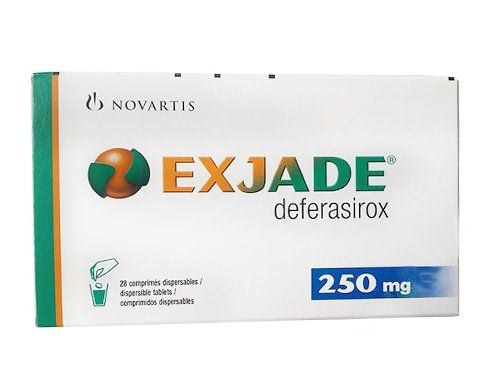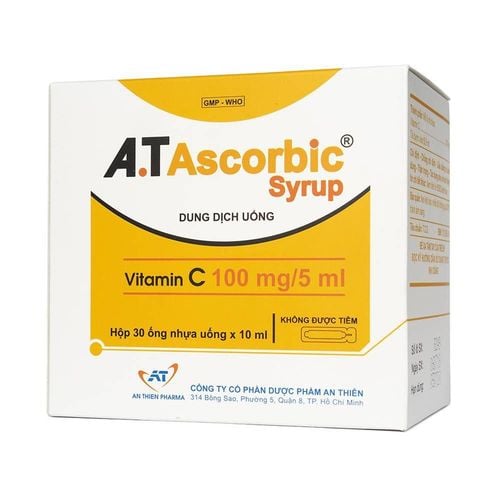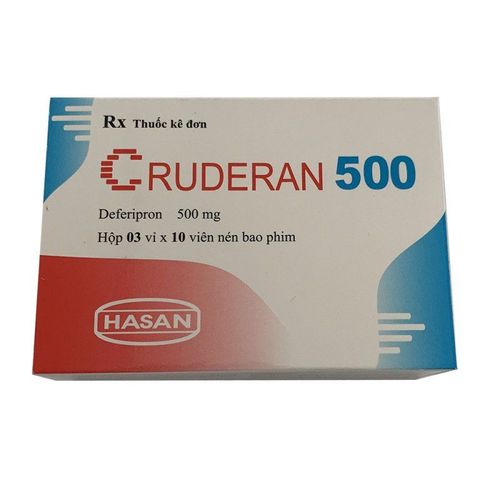This is an automatically translated article.
Paolucci is a domestic medicinal product whose active ingredient is Deferiprone. Paolucci is indicated for the treatment of an excess of iron in the body of patients.
1. What is Paolucci?
Paolucci drug is a product of Dat Vi Phu Pharmaceutical Co., Ltd., with the main active ingredient is Deferiprone, content 500mg. Paolucci is in the form of a hard capsule and should only be used as directed by your doctor.
Paolucci's active ingredient is Deferiprone, which is a 2 ligand that is able to bind to form chelate complexes with iron in a molecular ratio of 3:1. Deferiprone is rapidly absorbed from the upper gastrointestinal tract and is eliminated mainly by the kidneys.
2. What are the uses of Paolucci?
Paolucci is used to treat excess iron in the body, mainly in patients with Thalassemia but therapy with Deferoxamine is contraindicated or not effective enough.3. Dosage and usage of the drug Paolucci
How to use: Paolucci is used orally.
Dosage: Deferiprone is usually used at a dose of 25mg/kg body weight, 3 times/day, the total daily dose of Paolucci is up to 75mg/kg body weight. Doses of Paolucci above 100 mg/kg/day are not recommended because of the potential for increased risk of undesirable effects at this dose.
The effectiveness of Deferiprone in reducing iron stores in the body of patients is directly influenced by the dose of Paolucci and the degree of iron overload of each person. After initiating therapy with Paolucci, plasma ferritin (or any other indicator of body iron) should be monitored every 2 to 3 months to assess the chelating effect of Paolucci treatment. long-term, helps control the body's iron load. Dosage adjustment of Paolucci should be tailored to individual patient response and treatment goals. Discontinue Deferiprone if serum ferritin falls below 500 μg/L. Children: There is not much information available on the use of Deferiprone in children aged 6 to 10 years and there are no data on the use of Deferiprone in children < 6 years of age.
Note: The above dose of Paolucci is for reference only, the specific dose of Paolucci depends on the condition and progression of the disease, patients need to consult a doctor or medical professional.
Currently, no case of acute Paolucci overdose has been reported, however neurological disorders (such as cerebellar symptoms, diplopia, nystagmus, motor neuron impairment...) have been reported. was observed in children taking Paolucci 2.5 times more than the maximum dose of 100 mg/kg/day, for several years. The neurologic disturbances gradually subsided after stopping Paolucci . In the event of an overdose of Paolucci, the physician should closely monitor the patient's clinical condition.
4. Side effects of the drug Paolucci
When using Paolucci, patients may experience undesirable effects as follows:
Common side effects of Paolucci are: agranulocytosis. Side effects of the drug Paolucci unknown frequency: Vomiting/nausea, abdominal pain, diarrhea, joint pain, joint effusion, increased liver enzymes, urine staining. When experiencing side effects of Paolucci, patients need to stop using and notify the doctor or go to the nearest medical facility for timely intervention and treatment.
5. Contraindications of the drug Paolucci
Paolucci drug is contraindicated for use in the following cases:
Patients with hypersensitivity to any ingredient of Paolucci drug; People who are suffering or who have a history of neutropenia; Patients with a history of agranulocytosis; The use of Paolucci is contraindicated in pregnant or lactating women. The mechanism underlying Deferiprone's neutropenia is unknown, so Deferiprone should not be used with drugs that are capable of causing neutropenia or drugs that cause agranulocytosis.
6. Be careful when using Paolucci
Deferiprone is an active ingredient that has been shown to cause neutropenia, including agranulocytosis, so the neutrophil count of patients taking Paolucci should be monitored weekly; Monitor plasma Zn2+ levels and recommend zinc supplementation to patients in case of deficiency; There is no information on the use of Paolucci in HIV-positive or immunocompromised patients. Deferiprone can cause neutropenia and agranulocytosis, so immunocompromised patients should not be started unless the benefit outweighs the risk. There is no information on the use of Deferiprone in patients with renal or hepatic impairment. However, because Paolucci is eliminated primarily by the kidneys, this poses an increased risk of complications in patients with impaired renal function. Similarly, Deferiprone is metabolised in the liver, so Paolucci should be used with caution in patients with hepatic dysfunction. In patients with thalassemia associated with cirrhosis, iron overload and/or hepatitis C, careful monitoring of liver histology is recommended for this patient. Patients receiving Paolucci should be informed that urine may be red/brown due to excretion of the iron-Deferiprone complex; The use of Paolucci doses above 100 mg/kg/day is not recommended; Keep Paolucci out of the reach of children; There is no information that Paolucci affects the ability to drive and use machines; There is no complete information on the use of Deferiprone in pregnancy however animal studies have shown reproductive toxicity of Deferiprone, but the potential hazard of Deferiprone to humans is unknown; Women of childbearing potential should use careful contraception because of the carcinogenic and teratogenic effects of Deferiprone. These women should immediately discontinue Deferiprone if they become pregnant or plan to become pregnant. Lactation: It is not known whether Paolucci is excreted in human milk. Therefore, the drug Paolucci should not be used in lactating women, if treatment is imperative, then breast-feeding must be discontinued.
7. Drug interactions of the drug Paolucci
Due to the unknown mechanism of Deferiprone leading to neutropenia, patients should not use Paolucci with drugs known to be associated with neutropenia or possibly to cause loss of neutropenia. White blood cells; There have been no reports of interactions between Deferiprone and other drugs. However, because Paolucci is bound to metal cations, there is a possibility of an interaction between Paolucci and drugs containing trivalent cations such as aluminum-based antacids. Concomitant administration of Paolucci with aluminum-based antacids is not recommended; The safety of concomitant use of Paolucci and vitamin C has not been formally studied. However, based on reports of possible adverse interactions between Deferoxamine and vitamin C, patients should exercise caution when co-administering Paolucci and vitamin C.
Please dial HOTLINE for more information or register for an appointment HERE. Download MyVinmec app to make appointments faster and to manage your bookings easily.













